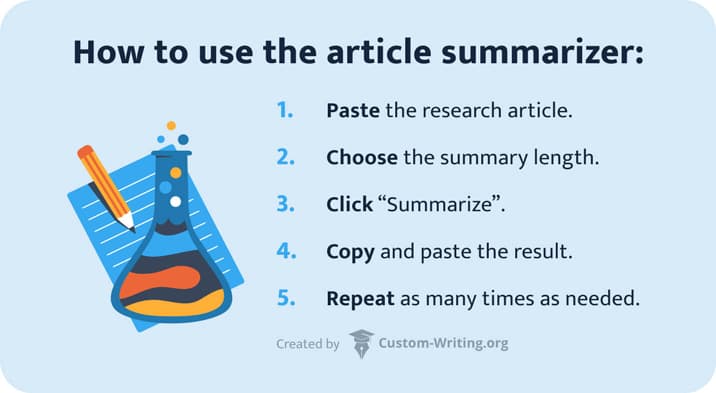🔢 How the Journal Article Summarizer Works
To summarize a scientific or journal article using this instrument, you will have to take the 5 steps below:
- Paste the academic article into the tool; ensure it doesn’t exceed 17000 characters.
- Choose the preferred summary length.
- Click “Summarize” and wait a few seconds.
- Copy the result and paste it into the word processor.
- Repeat as many times as you want.
🎁 Who Will benefit from the Journal Article Summarizer?
Speed-reading through numerous scientific texts is common not only in educational settings but also in various professional fields. Here’s who will benefit most from using our tool.
- Students. Summarizing scholarly articles has become an integral part of academic writing. Sometimes, students have to wrap up and simplify many scientific and journal pieces at once. Consider using this journal article summarizer to get a cut-down version of your resource for free and without losing any essential information.
- Teachers. A professional teacher is expected not only to have a solid understanding of their subject but also to stay updated with innovations in their field. This journal summary tool helps you quickly grasp the essence of scholarly studies, allowing you to prepare for lectures and seminars with greater ease and effectiveness.
- Researchers. An active researcher must regularly prepare literature reviews for their publications, presentations, and talks. Our tool simplifies this process by summarizing the most complex scientific articles. It saves you time, allowing you to focus on the most important information.
If you're working on academic research and need to gather key insights from multiple sources, our literature review writing service can be a real asset. We will ensure that your literature review is thorough, well-organized, and based on credible, high-quality sources. Let our expert writers assist you in creating a polished, comprehensive literature review tailored to your specific needs.
📝 3 Reasons to Use This Academic Article Summarizer
This research article summarizer can benefit researchers, teachers, and students. The tool will quickly condense complex materials into concise abstracts.

Here are some of the reasons for using this online tool.
-
It simplifies complex concepts.
Scholarly texts are full of specific jargon and can be challenging to understand. If you’re stuck on grasping the message of a lengthy scientific text, consider using our online tool. It will quickly summarize the journal article, capturing its key ideas and explaining them in simple terms.
-
It saves you time.
Reading academic articles can be both challenging and time-consuming. While crafting a comprehensive literature review, you might be required to read a lot of texts at once. That’s where the Custom Writing journal summarizer comes in handy! It takes care of the routine work, letting you focus on the most creative task: selecting the relevant articles and compiling them into a meaningful review.
-
It helps you focus on the key insights.
Lengthy academic texts often have a complex structure and contain tons of information that might (or might not be) relevant to your study. Sometimes, you feel lost in the text, and that’s where our research article summarizer can help. The tool highlights the most essential ideas and insights, guiding you through the most significant outcomes of the study.
Updated: